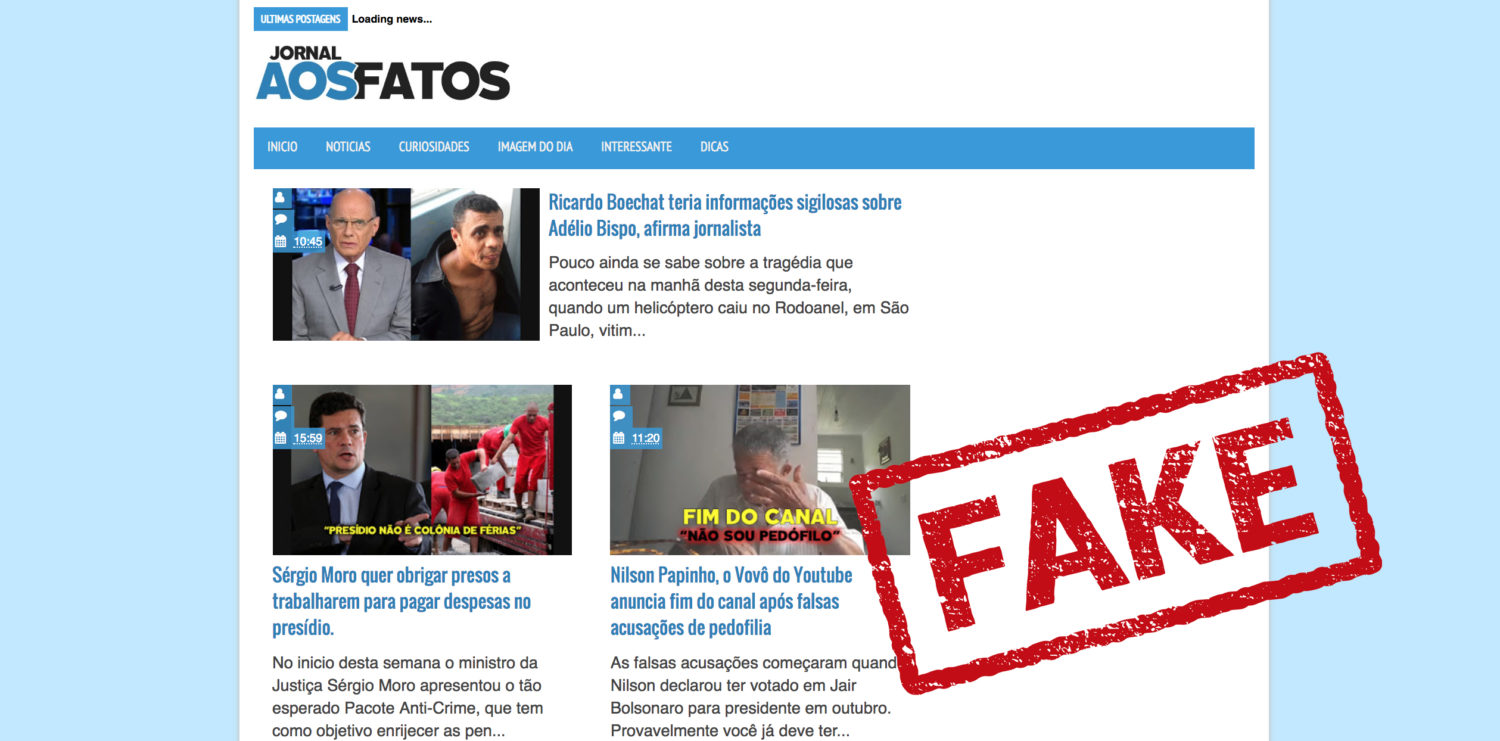Someone is publishing fake news stories on a website that looks like a fact-checking organization.
On Wednesday, Brazilian fact-checker Aos Fatos published an investigation about a fake news website that had ripped off its brand to publish bogus content. Instead of AosFatos.org, the network published to AosFatos.com.
Tai Nalon first got the tip.
“One of our readers sent me a message on Facebook saying he had seen that fake website. He had seen a post on Facebook about the death of a very famous journalist in Brazil,” said the Aos Fatos director. “And it was fake news — it was relating this journalist’s death to (President Jair) Bolsonaro’s stabbing during the election because it stated the journalists knew too much.”
Other hoaxes on the website, which appeared to be down as of publication, falsely claimed that the Brazilian justice minister wants to make prisoners pay expenses in prison and that President Bolsonaro threatened to shut down the newspaper O Globo. According to audience metrics tool BuzzSumo, the site’s articles had virtually no engagement on social media, with only two articles racking up tens of shares on Twitter.
Aos Fatos isn’t the first fact-checking project to be targeted by an imposter website.
In April, a copycat version of Swedish fact-checker Faktiskt launched two weeks before the real one did, publishing hyperpartisan stories that criticized fact-checkers. Belgian debunking site Lead Stories was also targeted over the summer by a marketing site that ripped off more than 7,000 of its articles.
But for Aos Fatos, the imposter website was only the tip of the iceberg.
“The same reader sent me a WhoIs analysis, which is where you can see who owns that URL,” Nalon said. “We saw that (AosFatos.com) started at the end of January. It was really recent.”
By using the tool SpyOnWeb, which tracks relationships between different websites, Nalon found Google AdSense and Analytics tracking numbers, which are used to monetize websites and track how well they perform. Through the code, Aos Fatos could establish a link between the original hoax site and a bigger network of fake news websites — one of which was the subject of a federal investigation.
“It was kind of crazy because it sounded amateurish,” Nalon said. “How could they link every site through AdSense and through Google Analytics? How could they expose their code so easily? It actually wasn’t hard to find out, right?”
Aos Fatos found five other fake news sites that had the same AdSense and analytics codes as AosFatos.com: O Detetive (which was offline as of publication), Plantão Brasil, Notícias Brasil Online, Pensa Brasil and Descobrindo As Verdades. Using the website traffic tool SimilarWeb, Aos Fatos found that both Pensa Brasil and Plantão Brasil had nearly 3 million visits in October, just before the election.
All the sites were posing as official news websites in order to peddle misinformation. Ironically, Aos Fatos had previously debunked them at least 14 times.
Still, according to the fact-checkers’ investigation, the most notable fake news operation linked to the imposter fact-checking site was O Detetive (“The Detective,” in English). During the lead-up to October’s presidential election, the website’s owner, Franciney Duda Lima of Sertãozinho, São Paulo, was summoned by a regional court for publishing a salacious story about how a member of Parliament had allegedly paid for a lawyer to represent the man who stabbed Bolsonaro on the campaign trail.
The court ruled the story aimed “to denigrate the reputation of the candidate, causing him electoral damage.” Aos Fatos reported that the story was then taken down.
Over the summer, Globo’s G1 platform profiled the owners of Notícias Brasil Online, “one of the sites with the largest sharing of news on the web.” In it, authors Rafael Brunetti and Hugo Dantas said that their sites did not publish fake news — even though G1 found that the duo published false stories under a fake pen name online.
“That story revealed the identity of two owners of that website. But nothing happened — they said that they would only use that website to publish stories that they found were true,” Nalon said. “They said that they weren’t publishing fake news even though they were.”
Khashoggi misinformation highlights a growing number of fake fact-checkers
There are still some things that Aos Fatos doesn’t know about the network of fake news sites.
Nalon said there’s no way of knowing if the people behind the imposter version of Aos Fatos were operating alone or being paid by someone else. And, when it comes down to it, they could have used false identities like Brunetti and Dantas did.
The only organization that would definitively know who’s behind the network is Google, which has handled the sites’ advertising revenue. But the company told Aos Fatos that it can’t release data about who owns the network because of privacy laws.
“We don’t know if they used fake names. We don’t know anything because those websites, those domains, are registered in different names from different people that they’re friends with, that they’re related with,” Nalon said. “It’s a very intricate network of fake news websites. It’s not that simple.”
“We didn’t mention who are they, because we’re are not sure who they are and what their real intentions are.”







